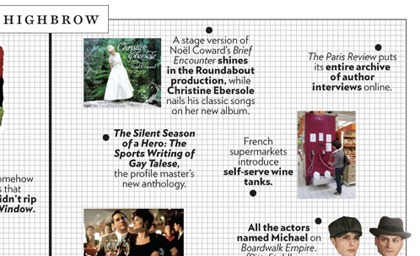Dr Vino's wine blog
wine talk that goes down easy
Chief bottle washer: the job is back in the wine biz
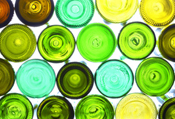 Chief Bottle Washer: the title is no longer just a punchline. Bruce Stephens is the CEO of Wine Bottle Renew, a California startup that washes and reuses wine bottles profiled in today’s Wall Street Journal.
Chief Bottle Washer: the title is no longer just a punchline. Bruce Stephens is the CEO of Wine Bottle Renew, a California startup that washes and reuses wine bottles profiled in today’s Wall Street Journal.
“You take a bottle and you empty the bottle, and my God, why would that only be a one-time bottle?” Stephens tells the Journal. He points to the lost era of bottle washing in milk bottles, beer bottles and even Coke bottles.
Reusing a bottle is an important way to reduce wine’s carbon footprint. In a paper I co-authored on the subject, we found that the manufacture and delivery of empty bottles to the winery accounted for anywhere from about half to three-quarters (depending on bottle weight) of the carbon dioxide emissions of a wine locally produced and consumed, taking into account all of production and delivery phases, including the vineyard and winery operations. Recycling is good since in introduces a closed loop. But reusing is better since the energy demands are so much less than recycling.
While the amount of bottles that Wine Bottle Renew can clean in a day still is a drop in the bucket of California’s wine production, it’s good to see that industry heavyweights Kendall Jackson and Sutter Home have invested in the company, which may indicate eventual broader usage.
Obviously, there isn’t a standard shaped wine bottle today as there was for milk or Coke back in the day. But what do you think: if it encouraged reuse, would you favor wine bottle standardization? I would, especially if the bottles were lighter (14- to 19-ounces). Sparkling wine producers could be the first adopters since there is little variation among their bottles, the heaviest in the wine trade.
New Zealand wine stomps carbon footprint on the label
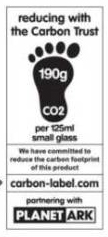 Starting early next year, some consumers will be able to buy a wine with a carbon footprint analysis on the label. Mobius, a new sauvignon blanc from New Zealand’s Marlborough region, will sport a calculation of greenhouse gas emissions on a per glass basis. Bottles destined for Australia will be the first to receive the notations; other markets will follow with custom calculations from the Carbon Trust, a nonprofit. The wine is made by New Zealand Wine Company, which also owns Grove Mill, run by emissions-guru Dave Pearce.
Starting early next year, some consumers will be able to buy a wine with a carbon footprint analysis on the label. Mobius, a new sauvignon blanc from New Zealand’s Marlborough region, will sport a calculation of greenhouse gas emissions on a per glass basis. Bottles destined for Australia will be the first to receive the notations; other markets will follow with custom calculations from the Carbon Trust, a nonprofit. The wine is made by New Zealand Wine Company, which also owns Grove Mill, run by emissions-guru Dave Pearce.
With so little space on the label, the graphic and number are helpful for a cursory indication. But it would be even more useful if carbon-label.org provided more information about the calculations. Hopefully the estimates will be conservative since, as my own research has shown, the mode of transportation matters as much or more than the actual distance traveled, making it difficult to put one number on a bottle for countries as big as Australia or the US, where a lengthy truck journey can add more to the GHG calculations than an even longer sea voyage.
Providing the methodology is acceptable, it is a step in the right direction. Given that wines entered in the Air New Zealand Wine Awards must now be certified “sustainable”, perhaps the industry will similarly provide some sort of carrot for other wineries to adopt carbon emissions labeling.
See the full label after the jump. Read more…
Wine bottle deposits come to Arizona [poll]
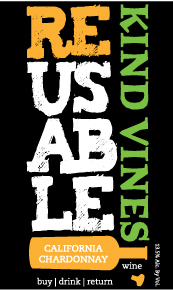 You want that wine on the shelf in Flagstaff, AZ? It’ll be $7.99–plus a $2 refundable deposit.
You want that wine on the shelf in Flagstaff, AZ? It’ll be $7.99–plus a $2 refundable deposit.
No, it’s not as if officials Arizona have implemented a bottle deposit law that would increase recycling and/or reuse while raising millions of dollars for state coffers.
This is a voluntary recycling program called Sustainable Packaging Solutions profiled on AZdailysun.com. Starting November 1, a group will debut a white and a red under the label Kind Vines, exclusively at Bashas’, a grocery store. Brought in from California in bulk, the wines will be bottled locally where the bottles will also be cleaned and refilled.
Are you into this idea, in theory? Have your say in the latest poll!
[poll id=”18″]
On Good Morning America, box wine edition
I had a great time on GMA today even if it meant waking up before the crack of dawn (although, with a two-year-old son, that’s not exactly a foreign concept to me). Sam Champion is a hoot; I appeared on his weekly segment, “Just One Thing.” It was fun, it was fast! With wine, we tried to put the “good” in Good Morning America!
Video follows below, as well as a cameraphone pic from the set!
America wants self-serve wine tanks: Who will fill ‘er up?
Do you want a self-serve tank that dispenses low-priced wines in a store near you? Apparently a ton of people do as lots of non-wine sites linked to a recent post here, hundreds of people commented via twitter, and over 5,250 people “liked” it on Facebook.
The reception was very positive with many comments akin to “I am moving to France–TOMORROW.” or “I want one of these in my kitchen.” Perhaps the ultimate compliment came from New York magazine which put the tanks on their approval matrix in the “highbrow-brilliant” quadrant in today’s magazine. The only thing more brilliantly highbrow was the Paris Review putting their entire archive of author interviews online! (Good thing they didn’t see a subsequent here about pairing wine with bacon doughnuts–oh wait, that dish came from them!)
Why do you think this post resonated so much, particularly outside of the wine world? I think that part of it had to do with the fact that Americans are really getting into wine but can certainly do with out the pompousness. Also, it is kind of a Nirvana to find a fountain of good, cheap wine. There’s certainly the environmental angle too. And then it is also just a little bit zany.
But for whatever reason, the enthusiasm for the posting shows an appetite for such dispensers in the US. Who will be the first to implement this here–Whole Foods? Trader Joe’s? Safeway? Binny’s? Whoever it is (and one person in the industry tells me he’s working on it), they can certainly be assured a lot of media coverage.
Fill ‘er up: self-serve tanks bring wine to French supermarkets
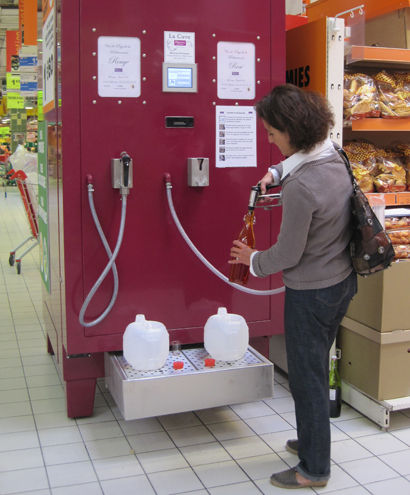
Keg wine and wine vending machines just got supersized: 500 and one-thousand liter tanks have landed in French supermarkets.
Bring your own resealable bottles, Poland Spring containers, jerrycans, whatever. Or you can get one at the store. Select your grade (red, white, or rosé). Pump. Print receipt.
Astrid Terzian introduced this concept that hearkens back to a bygone era when wine would arrive in Paris shops in tonneaux and consumers would bring their own flagons to fill. But today, Terzian says, she started this scheme in fall 2008 to fill a niche, tapping into two key themes, environmental awareness and the economy. (She actually wanted to buy a wine property and run a B&B but it was too expensive. So she turned to what she says she knew how to do: sales.) The elimination of packaging mass means that the wine can be shipped much more efficiently from a cost and carbon perspective.
The cost-savings are passed on to the consumer in the form of low prices of 1.45 euros/liter (about $2/liter). She installed her first machine in June 2009 at the Cora supermarket in Dunkirk and now has them installed in eight supermarkets in France. The wines vary; one is a 2009 from the Rhone, technically a vin de pays méditerranée.
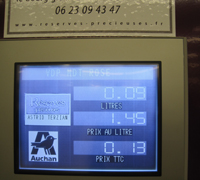 As to customer reaction, Terzian says customers are taken aback at first, but then warm up to the idea, especially after a taste. They come back often, she says.
As to customer reaction, Terzian says customers are taken aback at first, but then warm up to the idea, especially after a taste. They come back often, she says.
Asked via email which is her favorite container to bring to fill, she says she uses a five-liter jug since it is “neither too big nor too small–and it’s typically French.”
UPDATE: I neglected to mention in the post that I think this, regulations permitting, will come to the US within a year. I told that to someone in the wine trade today. And he replied that he is already working on it!
UPDATE 2: My only question about the pump wine (aka Chateau La Pompe) is if it comes to New Jersey and Oregon, will they require full serve as they do for gas?!
Designing a lighter Champagne bottle
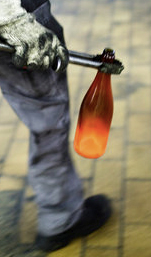 Have you ever lifted a bottle of champagne and thought, “Wow, that’s heavy!” Well, the bottles are heavy partly with good reason: to contain all the sparkly goodness, which can be six times the atmospheric pressure. (And, of course, there’s a little bling factor to the bulk.) Apparently, before sufficiently strong bottles were developed, cellar staff in Champagne would enter the caves with masks akin to a hockey goalie’s to protect against exploding bottles.
Have you ever lifted a bottle of champagne and thought, “Wow, that’s heavy!” Well, the bottles are heavy partly with good reason: to contain all the sparkly goodness, which can be six times the atmospheric pressure. (And, of course, there’s a little bling factor to the bulk.) Apparently, before sufficiently strong bottles were developed, cellar staff in Champagne would enter the caves with masks akin to a hockey goalie’s to protect against exploding bottles.
Thus physics is a main challenge of reducing the bulk the Champagne bottle. A detailed story in today’s NYT Business section traces the development of a new, lighter bottle, slimmed down to 835g from 900g. The bottle has taken years to design and the Champagne Trade Council (CIVC) is encouraging its members to use it starting with this harvest, all in the name of reducing the wine’s greenhouse gas emissions. The lighter bottle means 2,400 more bottles can be fit in the same sized truck, thus reducing the amount of trips needed. That also saves producers costs, although industry figures in the story say that the bottle is not cheaper–unless it is widely adapted, which would drive down costs.
“Champagne Producers Aim for ‘Greener’ Bottle” (with slideshow)
cropped photo attributed to Stéphane Lavoué for the International Herald Tribune
Wherefore art thou, rosé in a box?
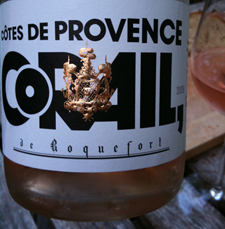 A couple of years ago, I had an op-ed in the NYT arguing for wine in a box. Since then, box wine sales have skyrocketed and many more selections, both foreign and domestic, have come on the market.
A couple of years ago, I had an op-ed in the NYT arguing for wine in a box. Since then, box wine sales have skyrocketed and many more selections, both foreign and domestic, have come on the market.
But one category that seems woefully underrepresented stateside is rosé. Given that it is perhaps the quintessential “here today, gone tomorrow” kind of wine, it seems particularly well-suited for the bag-in-box format. Fridges across France are stocked with box rosé in the summer; it’s almost a summer rite to come in from a warm day and squeeze off a nice cold one (rosé, that is). And, it’s clinically proven that having a box of rosé is also a great way to make friends with any passersby since it’s always cold and is likely a tremendous value.
Last week I was on vacation and wished I had a box of rosé in the fridge. But I couldn’t find one. Fortunately, we had some of the snappy Chateau de Roquefort, “Corail” 2009 from the Cotes de Provence. Maybe next summer, I’ll be able to squeeze off a glass when I’m on vacation?
